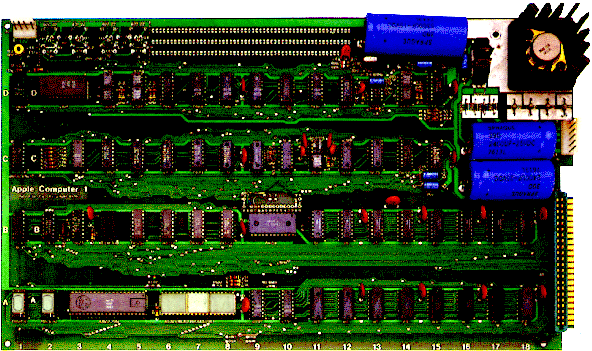
Apple Computer Company · 770 Welch Rd., Palo Alto, CA 94304 · (415) 326-4248
Page 1 | <Click> | Page 2
pcbiography.net
| The first APPLE |
| The Apple
Computer. A truly complete microcomputer system on a single PC board. Based
on the MOS Technology 6502 micro-processor, the Apple also has a built-in
video terminal and sockets for 8K bytes of onboard RAM memory. With the
addition of a keyboard and video monitor, you'll have an extremely powerful
computer system that can be used for anything from developing programs
to playing games or running BASIC.
Combining the computer, video terminal and dynamic memory on a single board has resulted in a large reduction in chip count, which means more reliability and lowered cost. Since the Apple comes fully assembled, tested & burned-in and has a complete power supply on-board, initial set-up is essentially "hassle-free" and you can be running within minutes. At $666.66 (including 4K bytes RAM!) it opens many new possibilities for users and systems manufacturers. You Don't Need an Expensive Teletype.
|
avoid all the expense, noise and maintenance
associated with a teletype. And the Apple video terminal is six times faster
than a teletype, which means more throughput and less waiting. The Apple
connects directly to a video monitor (or home TV with an inexpensive RF
modulator) and displays 960 easy to read characters in 24 rows of 40 characters
per line with automatic scrolling. The video display section contains its
own 1K bytes of memory, so all the RAM memory is available for user programs.
And the Keyboard Interface lets you use almost any ASCII-encoded keyboard.
The Apple Computer makes it possible for many people with limited budgets to step up to a video terminal as an I/O device for their computer. No More Switches,
|
display and debug programs (all in hex) from
the keyboard, rendering a front panel unnecessary. The firmware also allows
your programs to print characters on the display, and since you'll be looking
at letters and numbers instead of just LED's, the door is open to all kinds
of alphanumeric software (i.e., Games and BASIC).
8K Bytes RAM in 16 Chips! The Apple Computer uses the new 16-pin
4K dynamic memory chips. They are faster and take 1/4 the space and power
of even the low power 2102's (the memory chip that everyone else uses).
That means 8K bytes in sixteen chips.
|
